Service Design Award 2020/21 Finalist Project
Working With Children Check for Indigenous applicants - by Today
Category: Professional Non-profit / Public sector
Client: Office of the Children's Guardian
Location: Australia

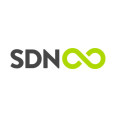
We worked with an independent state government authority to deeply understand the experience for Indigenous Australians in applying for a Working with Children Check (WWCC), and how the impact from not having one plays out to great detriment.
Category: Professional Non-profit / Public sector
Client: Office of the Children's Guardian
Location: Australia
Indigenous Australians are massively over-represented within basic social, economic and health indicators; with large over-representation in Australia’s justice, child-protection and health systems. Many of these challenges can be solved through the ability to work and to look after family. But to do this, you need a Working with Children Check (WWCC).
WWCC’S are a cornerstone of a well functioning Child Protection system. They are designed to stop perpetrators of harm having access to children—they are a necessary and valuable part of our society. Our client, an independent state government authority, identified that a tiny proportion of Australian Aboriginal people were accessing the WWCC, a mechanism that’s required for any adult to look after children or work in a place accessed by children.
We were engaged to understand the experience of Indigenous Australians in applying for the check, understand the impacts that limited access brings, and work with community and service providers to remove the current barriers and develop the future service. Working With Children Checks are required to gain work looking after family in foster and kinship care arrangements, to be eligible for government-funded training, and to access social support ‘safety nets’ like Job Seeker programs.
In remote communities, this matters a lot. Where a community isn’t able to access and gain a WWCC, local trades, schools, NGOs and government services cannot hire locally. In an environment where the Indigenous unemployment rate is over 50%, this represents a significant barrier to ‘closing the gap’ of indigenous inequality and fuels indigenous dislocation from Country.
This has intergenerational consequences and perpetuates systemic difficulties that Indigenous Australians have faced since colonisation. This represents a challenge and responsibility for all Australians in terms of how we truly reconcile the past and weave together a shared future.
Overwhelmingly, we found the check is difficult for Indigenous Australians to navigate. There are multiple barriers to being able to complete the process: Many applicants simply have never had ID, or access to a computer so cannot move through the process—triggering embarrassment, shame, and deeper emotional, psychological and cultural issues. The consequence was either fear of starting the process at all or dropping out partway through, which—in turn—subverted people's needs, rights, culture, and their ability to maintain livelihood and function well in the community.
The outcome of our work was a process that supports Indigenous people and their experience with clear and appropriate mechanisms to increase WWCC’s and deliver better outcomes for Indigenous Australians across New South Wales, Australia. It is designed to maintain the WWCC regulatory framework—essential for ensuring the safety of Australian children—while creating a service for Indigenous people, by Indigenous people.
The client demonstrated great bravery and commitment to being accountable to Indigenous communities and taking on a complex stakeholder landscape with a myriad of government partners. But it has paid off. This is a landmark service design initiative that will help to ‘close the gap’ of Indigenous inequality in a meaningful way. It sets a precedent for the benefits of engaging meaningfully with our traditional custodians to provide culturally appropriate services.
1 https://closingthegap.niaa.gov.au/
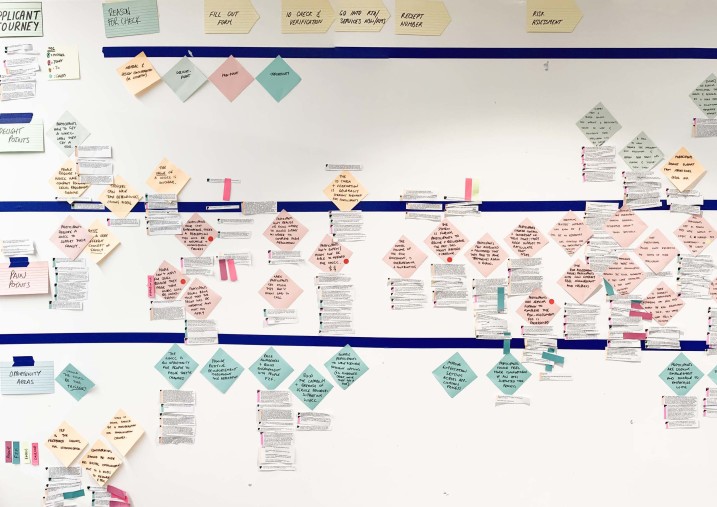
We developed a fit-for-purpose methodology that ensured full accountability to our end users, to build empathy, and develop local ownership of the project. Universal design practices captured the needs of vulnerable cohorts, while multiple design feedback loops ensured all stakeholders and teams were active parts of the design process through each phase.
Working collaboratively with the client, Indigenous elders, connected service providers and communities, the project developed a future service for Indigenous Australians that is culturally appropriate and sets a clear way forward together. We honed in on mapping the current system and developing a service that meets community and cultural needs, and stops the cycle of dislocation, cultural deterioration, community fragmentation, and enables active healing and reconciliation.
This was done through deep empathy and collaboration and targeting system levers that would create the most impact. It was enabled by working with an amazing organisation who were deeply committed to enabling Indigenous Australians and ‘closing the gap’.
Throughout the project’s four phases, we followed cultural protocols to ensure respectful relationships, such as asking for elder approval to come on-country and to proceed with the project. We worked shoulder-to-shoulder with the Indigenous liaison in our project team. It was essential to develop cultural guidelines for our methods of engagement and to meet people in their place.
We built this service approach specifically to understand accessibility, comprehension, diversity, system complexity, engage applicants and employees, credibility and accountability of the service and deliver on strategic goals.
Research activities and tools
As this was a participatory approach with the organisation to ensure change was implemented with Indigenous people and service providers there were multiple types of research and participatory design activities including qualitative research, cultural process and engagement, fieldwork and systems mapping, co-design and prototyping and building cultural frameworks to design, prioritise and evaluate by.
We did not take a linear journey approach, we embraced a complex service system and fully understood and leveraged interdependencies between services to inform the solution. By exploring and collaborating across services and thinking about how applicants transitioned from one service to another we could make gaps in the safety net visible and build a strong hypothesis around why people fall through the cracks; that this is fundamentally about service connections between providers, as opposed to individual services.
Throughout the project we built capability with the client in service design to drive forward operational change and deeply embed the experience of vulnerable cohorts within how decisions are made, service changes delivered and how measures of success are defined and are met.
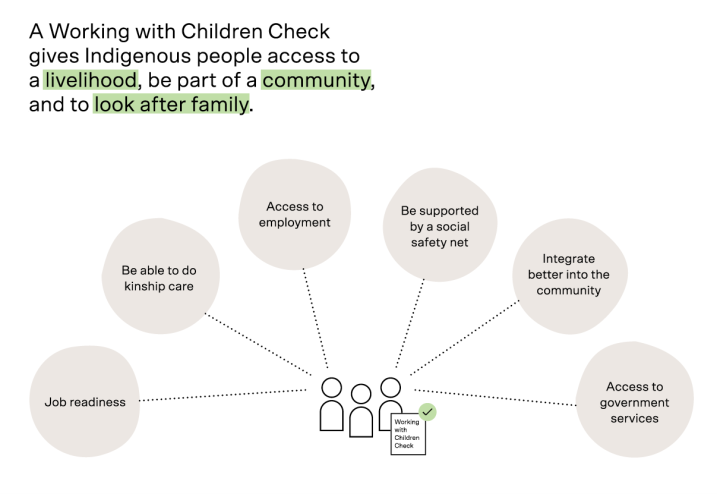
Specific methods
Community Immersion: We developed a ‘Community Immersion’ fieldwork approach to engage locally within the community and also completed cultural mapping, spatial analysis, service system mapping and an evaluation of community vulnerability to ensure we integrated context fully into how we identified barriers, developed opportunities and designed outcomes. This ensured we could see the reality of the challenge in-context, and address the complexity head on.
Applicant interviews: We did a first round of one-on-one interviews and group sessions with Indigenous applicants and potential applicants to journey map, further develop hypotheses and fully understand the experience and the needs of these individuals.
We followed this with a second round of applicant interviews who had been risk assessed, as we had identified this was the key barrier to moving through the process. We explored their experience, identified and prioritised opportunities and designed how this could work better in the future.
Cultural mapping and impact analysis: We synthesised and interrogated the insights with the indiginous liaison to again go deeper in terms of understanding culture dynamics, systems interrelationships and intergenerational trauma.
Service co-design and prototyping: This in turn informed detailed prioritised service changes that we co-designed with the organisation team members to further develop service changes and prototype these changes. We supported the organisation to critique the changes, develop a backlog of features and allocated responsibilities. We developed a plan for next steps including further prototype validation, engagement and co-design with Indigenous communities.
Strategy: Through visualising the journey and working closely with teams on the service concepts, we developed a number of high-level strategic recommendations and service changes that impacted the whole service. These were endorsed and delivered as part of an organisational Working Group.
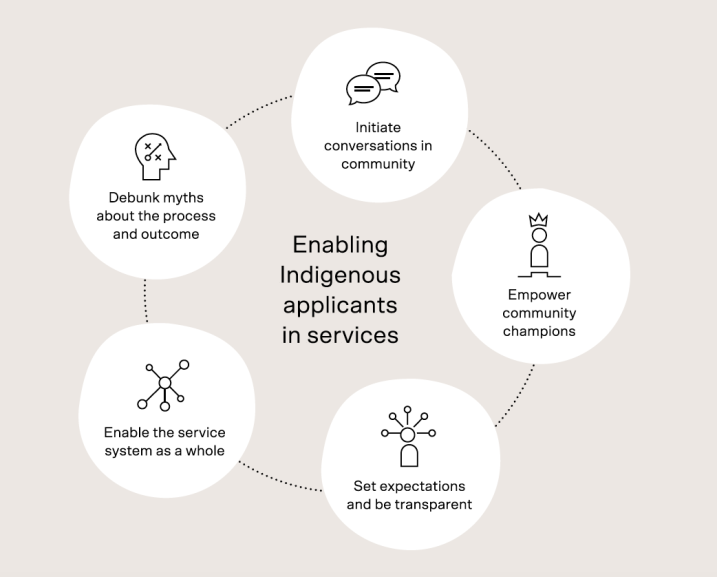
“For black people and the government it's a struggle, it's been a struggle since day one and for us to go through all this bullshit to prove that I'm a changed man.” [Participant]
We identified and prioritised ways to improve the experience, processes and engagement with Aboriginal applicants. We defined culturally-relevant processes that are technologically apt and suitable no matter the location. By doing this we ensured that services are more inclusive, accessible and culturally relevant.
The outcomes from this project were:
The project resulted in the development of processes and strengthened community connections that support Indigenous people to engage with and obtain a Working With Children Check; a crucial mechanism to ensure Indigenous Australian adults can safely care for Indienous Australian children.
This new check is making a significant contribution to narrowing the gap in Indigenous inequality that perpetuates ongoing cultural, social, economic and geographic displacement of Indigenous Australian adults and children. The solution that this project offers is scalable across other communities, vulnerable cohorts and complex service systems.
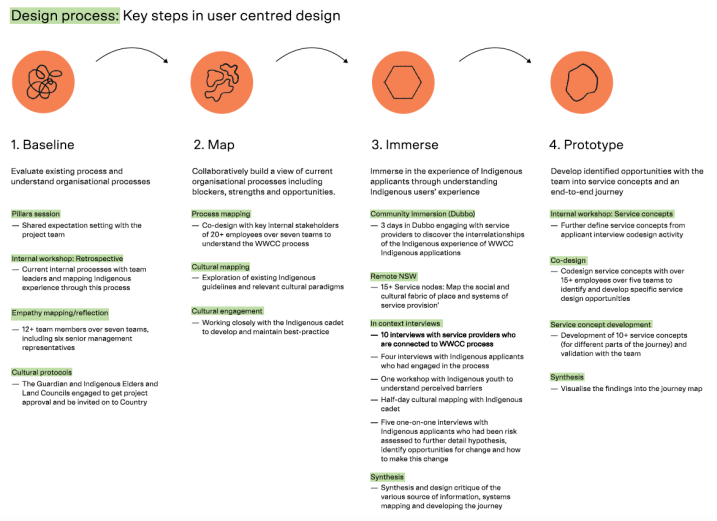
Our solution for a separate WWCC process for Indigenous Australians has been endorsed by the client and all recommended service delivery mechanisms are being adopted. The positive social impact is far reaching and we are only in the early stages of reporting. The project was recently completed in May 2019.
There’s been a shift in Indigenous community engagement techniques and communications, with case-by-case face-to-face channels established and collaboration between other key services to ensure flow-through and limit barriers such as ID checks and the way in which risk assessments are done.
Pilot applicants had been approved by the time we finished our part of the project and one has already become a champion in his community to support other Indigenous people to get through the process; highlighting a successfully handed off and locally owned service design solution.
Successful Indigenous WWCC applicants now have better access to government support, employment opportunities and the ability to support family members. Over time this will increase livelihoods and community outcomes for each person and their family.
We designed an Indigenous WWCC that has been successfully implemented across New South Wales, Australia. This specific check is increasing people’s access to work and services, and—critically—ensuring that more Indigenous children are being cared for within their own communities.
Working with our traditional custodians, this solution is a key tool in ‘closing the gap’ and actively building reconciliation by providing culturally appropriate support for every Australian.
The difference within the two WWCC’s are:
To approach this challenge there were multiple facets that we needed to consider to co-design appropriately. It was essential to properly understand the experience of Indigenous Australians; what it’s like to apply, how it relates to intergenerational trauma and discrimination, and what specific community needs are.
We developed a solution that was embedded within the organisation; ensuring stakeholders felt ownership of the next steps by the time the project was complete.
Our responsibility as Australians is to reconcile the past and work together to build a shared future. Through the implementation of an Indigenous WWCC, we can break the cycle of negative intergenerational consequences and enable more Indigenous people to keep connected to their kinship groups, culture and identity, gain employment and ensure children stay safe at all times.
Project Team:
Philippa Abbott - Head of Design
Alex Moshovelis - Senior Service Designer
Evie Davies - Service Designer
Sally Woellner - Design Lead
Lara Ihnatowicz - Senior Producer
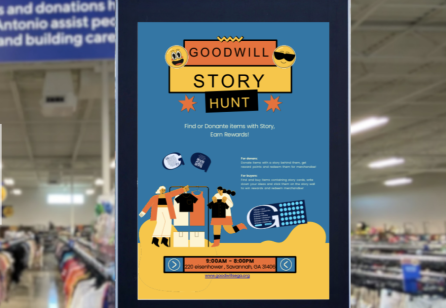
Service Design Award 2024 - Student Finalist
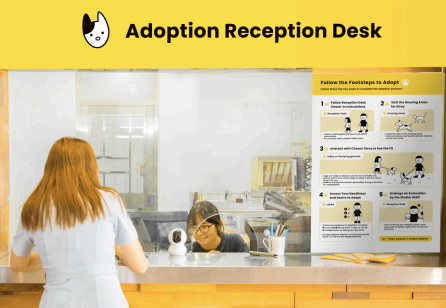
Service Design Award 2024 - Student Finalist
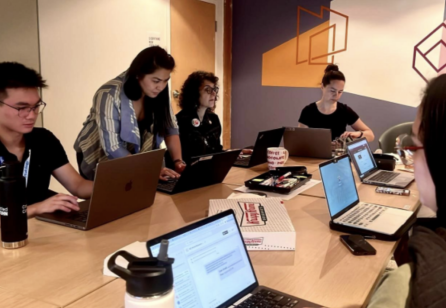
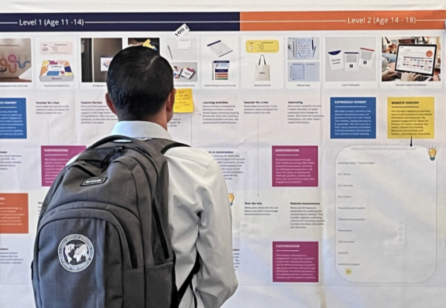

Share your thoughts
0 RepliesPlease login to comment